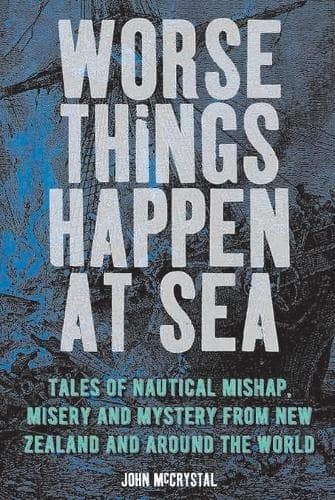Review: Worse Things Happen at Sea: Tales of nautical mishap, misery and mystery from New Zealand and around the world
Reviewed by David Hill
I could never write non-fiction like John McCrystal's. I'm not respectful enough. I don't mean “respectful” as in deferential. I mean as in attentive to detail, meticulous with facts, balanced in viewpoint. Like too many fictioneers, I tend to see facts as being at the service of the narrative: malleable incidentals to be reshaped as the plot requires. I am indeed saying that I don't let them get in the way of a good story. Or a story of any calibre.
McCrystal is one of our most versatile non-fiction writers. He's the sometimes unacknowledged author of books on Antarctic geography, marine history, sport, cars. I cribbed a photo of his once, for a story (a moderately accurate story) that I wrote about my parents' Austin A30.
So, you open one of his books confident that you're in the company of a professional. And what does Worse Things Happen At Sea give you?
It's the histories of 20-plus shipwrecks and/or nautical calamities, near or far from Aotearoa New Zealand. Chronologically, they begin in 1810, when the brig Active vanished off the South Island's West Coast. They range up to the Costa Concordia's 2012 shambles in the Mediterranean when the “reclining skyscraper” of a cruise ship hit rocks after the captain made a belated appearance on deck with his Moldavian dancer mistress beside him.
The book is divided into three sections: MISERY, MISHAP, MYSTERY, with some nifty chapter headings: Karmic sharks.... Slow-motion shipwreck.... Epic show-off fail (I and II). The Wāhine is here; so is the Titanic. Standout for me is the unidentifiable one: an early 19th century wreck near the Buller River mouth. McCrystal compares historical records, searches Papers Past, even analyses types of timber, ends up asking “So what the hell was it?”
Inevitably, there's a repetitive quality to the stories. Ship sets sail; ship meets disaster; ships and ship's company suffer consequences. But each episode has its building tension, climactic sequence and resolution. It's a book to read a few chapters at a time so details can form and settle.
There's something fresh (for me, anyway) to learn about each catastrophe. A nearby vessel thought the Titanic's distress flares were a fireworks display. Survivors of the gold-bearing General Grant went on lecture tours to describe their 18-month ordeal, wearing the sealskin clothes they'd made with albatross bone needles. You'll be enchanted to hear how one inventive analyst speculated that all those on board the Mary (sic) Celeste were plucked off ship and planet by aliens from the planet Mu.
McCrystal is severe when appropriate, as in the avalanche of incompetence that sank the Princess Ashika off Tonga in 2009. He's compassionate toward the unfortunate, with a searching outline of the USS Indianapolis, torpedoed in the Pacific as World War II neared its end, leaving hundreds floating in shark-filled water. Captain McVay was blamed for negligence, even though the Japanese submarine commander testified in his favour. Two decades later, McVay killed himself.
Quirky details (the cruise ship so ludicrously opulent that its seawater-therapy pool had a movie screen), plus some presumably imagined dialogue and detail - “kisses were blown and arms waved till they ached” – keep the narratives stepping along.
Photos, engravings, lithographs (a number in authentic shades of sepia) enhance the period flavours. There are dramatic images of vessels listing and disintegrating; survivors being carried onshore in rags; underwater shots of the Mikhail Lermontov with barnacle-encrusted Soviet emblem and a great rip along one side of its hull.
I'll finish by returning to that “respectful” of the first paragraph. John McCrystal is careful with his facts, thoughtful in his judgements, painstaking yet also entertaining in his renderings. It's an attractive combination.
Reviewed by David Hill
